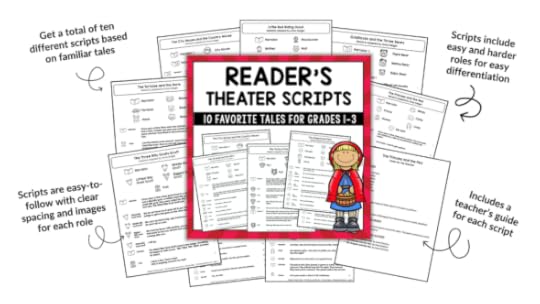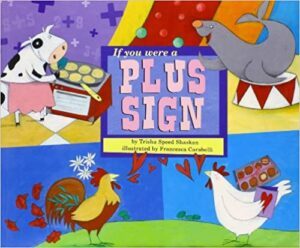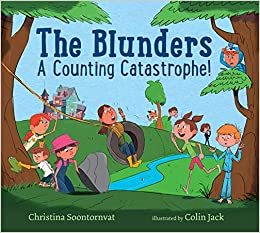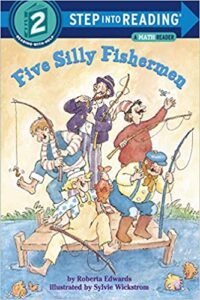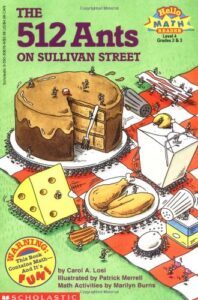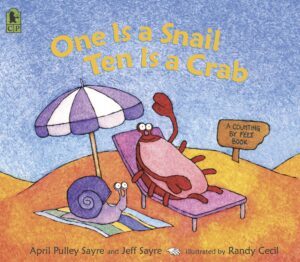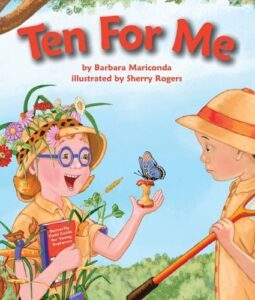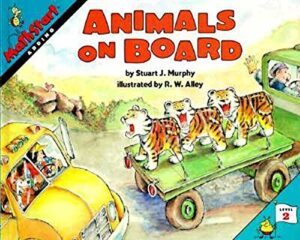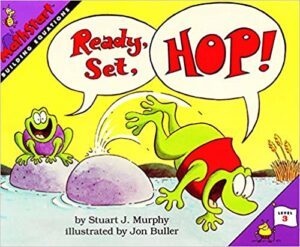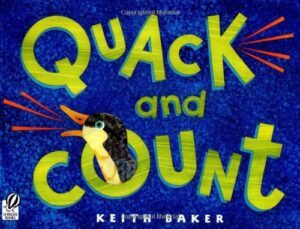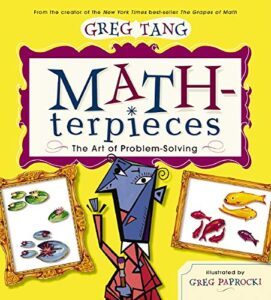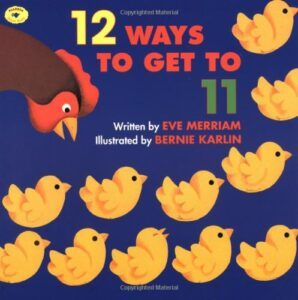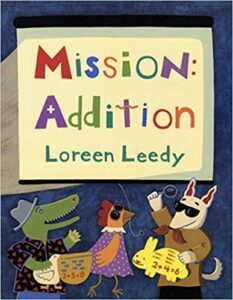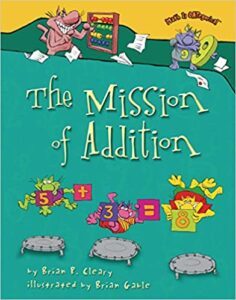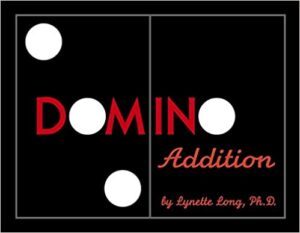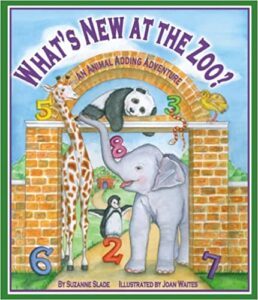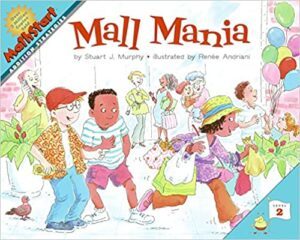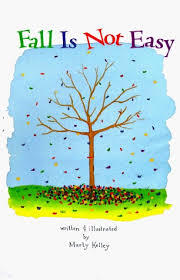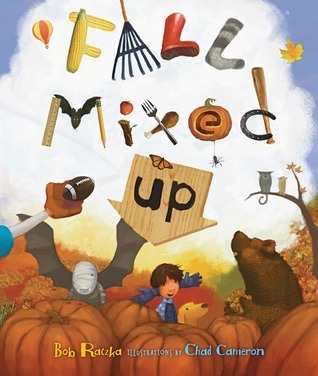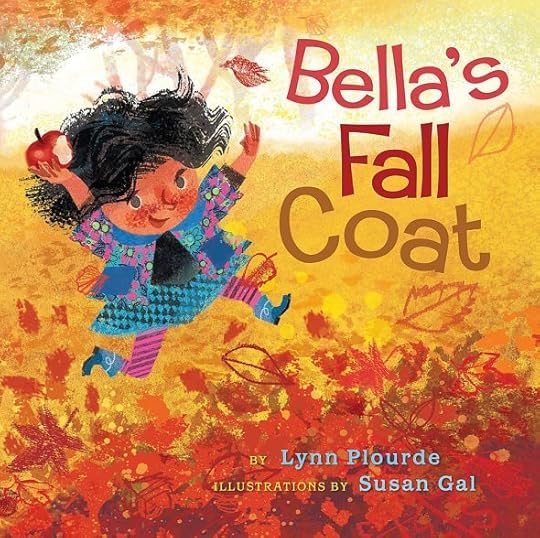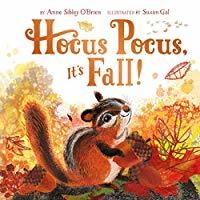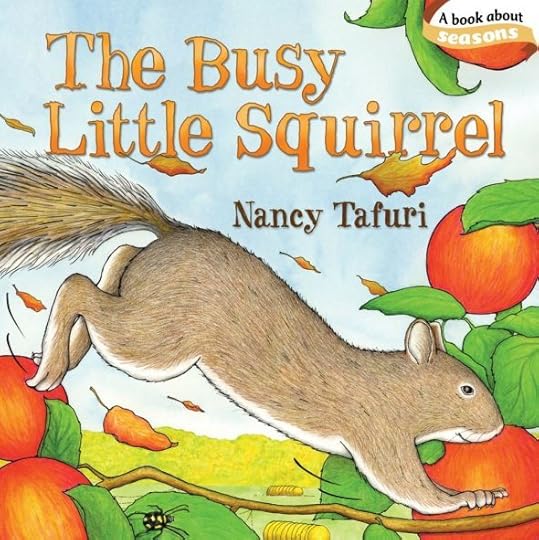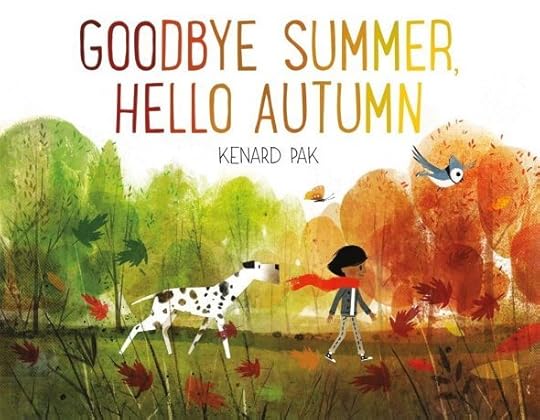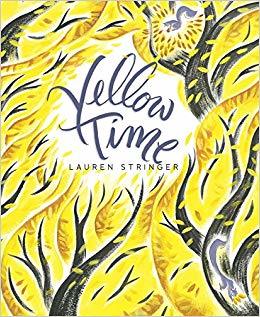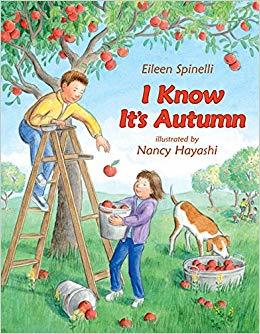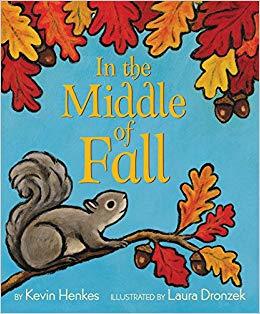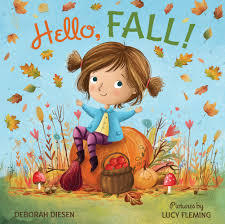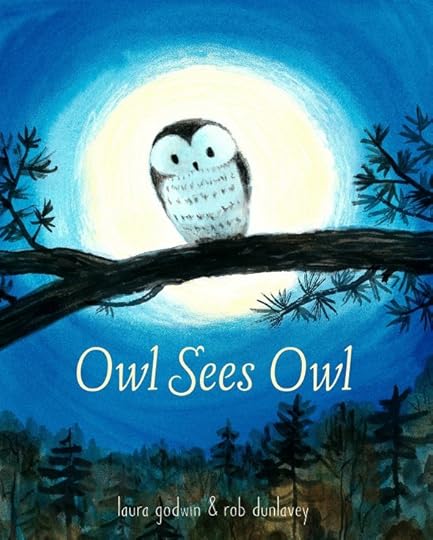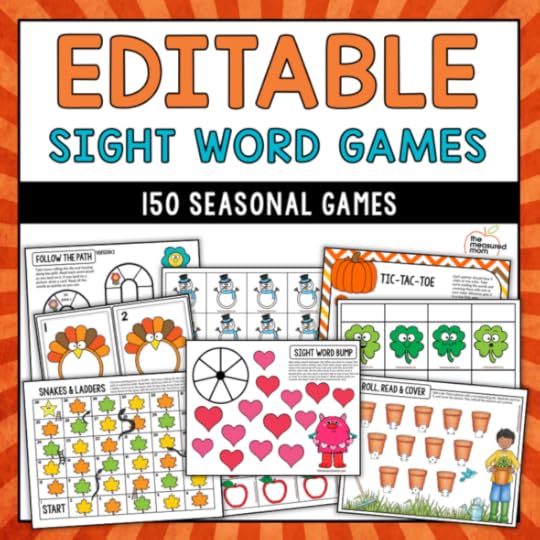Anna Geiger's Blog, page 31
September 29, 2020
3 tips for improving fluency
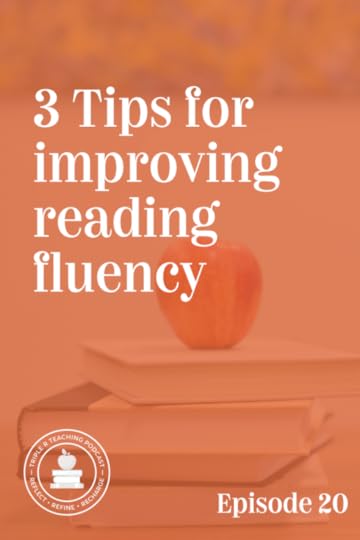
TRT Podcast#20: 3 Tips for improving fluency
How can we help struggling readers build fluency?
In this episode you will
learn how to teach what it means to be a fluent reader
discover the best texts for students to use when partner reading
learn what texts help students build fluency during independent reading
Listen to the episode here
Full episode transcript
Transcript
Download
New Tab
You are listening to episode 20, 3 Tips For Improving Fluency. Welcome to the seventh episode in our Struggling Readers series.
Last week, we talked about what to do when kids don't remember what they read. Today, we're going to talk about improving reading fluency.
Fluency, as you know, has three parts. It's the ability to read accurately at an appropriate speed with proper expression. So often our learners, and sometimes their teachers, think that fluent reading means reading fast, but fluency is our bridge to comprehension. And in fact, sometimes (particularly when we're reading a challenging piece of nonfiction), fluent reading actually means slowing down to help us understand. There's a lot we can do to help our learners improve their fluency. And today I'm going to share three tips.
Number one, be explicit about what it means to read fluently. In other words, model fluent reading and talk about what it is about your reading that makes it fluent. A great time to do this is during shared reading. So you have a large text that you're using together with your students, you model reading it and then you talk to your students about what it is that you did to make that reading clear. For example, you can call attention to punctuation and talk about how you adjusted the way that you read based on those punctuation marks. Or you can call attention to dialogue and talk about how you adjusted your speaking based on who was talking in the story.
Another time to explicitly teach what it means to be a fluent reader is when you're reading aloud to your students. When you're reading something challenging, talk about why you slowed down. So perhaps you're reading something in a science or social studies text. It was an advanced concept and so you slowed down as you read it to your students. Talk about why you did that.
This can just happen naturally in your day as well. Imagine that you have a piece of equipment in your classroom that's not working properly. You pull out the instruction book and you read it slowly so you can figure out what's wrong. Or if you didn't understand, you read it again. Talk to your students about why you did those things so they can understand that's what fluent readers do. They monitor their comprehension and adjust their reading rate accordingly. So, that's one thing you can do to help readers improve their fluency is to be explicit about fluent reading.
Number two is to use partner reading for oral reading fluency. Partner reading is when you have two students, they may be at about the same reading level, taking turns, reading a text. And I believe that there are so many benefits to partner reading, but the best reason is it gets students to read more. That's what they need, time to read. Partner reading helps them improve their word attack skills, builds comprehension and increases fluency.
It also increases engagement. They enjoy it, so they do it more, which means their fluency improves. I recommend doing partner reading regularly rather than hit or miss. You can have the whole class doing partner reading at once, or you can make it be a learning center that kids do several times a week. If you're wondering about the logistics of all this, I spell it all out in a mini-course, inside The Measured Mom Plus, my membership site for pre-K through third grade educators. And in that mini course, I explain when to do partner reading, how to choose partners, what kids should read when they're partner reading, ways they can read, how to get them to talk about what they're reading, and how to manage partner reading so it doesn't get too loud or out of control.
In this podcast episode, though, we're just going to focus on one of those things. I want to talk about what kids should read when they're reading with a partner. I recommend texts that easily lend themselves to people taking turns. So while they can certainly take turns reading pages of a chapter book or picture book, it's ideal if you can find texts that work especially well.
So, for young readers, books that have a lot of speech bubbles, for example, The Elephant and Piggie books by Mo Willems are great for partner reading. Poetry works really well. They can take turns reading lines or verses. There's a really good book series called I Read To You, You Read To Me. It has a lot of silly tales, usually fables or fairytales that are read in a partner rhyming fashion.
My very favorite reading materials, though, for developing fluency with partner reading are Reader's Theater Scripts and partner plays. So, Reader's Theater is when you have a bunch of children reading together, usually four to five parts, so that might not work as well for partner reading, but what works really well are Partner Plays. And those are plays with just two individual parts. And so students can practice reading it multiple times and they can take turns reading each of the parts. Rereading text is so important for building fluency and it can be hard to find texts that kids want to read over and over again.
Partner Plays really help with that, especially when they're fun. Inside The Measured Mom plus I've been sharing a variety of partner plays. Last I checked there were at least nine sets. Each set has three different plays in different levels, so you can use one set for your whole class, but assign different plays depending on the reading level of the pair. I highly recommend checking those out if you're in The Measured Mom Plus. If not, it's worth checking out the membership just to check out those partner plays, and you can learn more at themeasuredmomplus.com.
My final tip is to help students choose texts that will build fluency as they read on their own. Now, in this case, they may or may not be reading aloud depending on their level, but you can still find texts to support their fluency. Emergent readers, our very first readers, benefit from reading texts with a pattern. This is my hat. This is my coat. This is my scarf. Move ahead a little bit and early readers build fluency by reading texts with repeating sentences and phrases. So, the whole book doesn't follow a pattern, but there may be repetition within the book. And as students grow in their reading ability, they really benefit from reading series books.
For young readers, this may be Henry and Mudge by Cynthia Rylant. As they get older, we have The Frog and Toad books by Arnold Lobel. Eventually they can move to more challenging chapter books like The Magic Tree House series by Mary Pope Osborne or Cam Jansen by David Adler. And then, build on those to more and more advanced chapter books. As for why series books are good for building reading fluency, I'm going to share a quote with you from the book practical fluency, which I will link to in the show notes. "Series books provide students with similar background knowledge. Students learn how a character acts, talks, and reacts while reading a series of texts. Students become comfortable with a writer's style, know the setting and how to follow the plot structure. Students use this background knowledge to read fluently."
Those are my top three tips for improving reading fluency with kids who are struggling. You want to be explicit about what it means to be a fluent reader through your modeling and talking about it. You want to make sure that your students have a chance to read out loud together. Partner reading is ideal. I know if you're listening to this in real time, we are in COVID-19 and this may not be possible, but if your students are learning at home, you can certainly send partner plays home for them to read with a parent or sibling. And it's possible kids could do partner reading over Zoom or FaceTime. Finally, the third tip was that you should make sure that students have books that lend themselves to building fluency when they're reading on their own. Those types of book will vary depending on the reader's level, but emergent readers benefit from pattern books, early readers benefit from books that have repeating phrases. And then our more advanced readers benefit from reading series books.
If you are looking for early chapter books series, I have an amazing blog post. It took me six months to put it together and it's got over 250 early chapter books series with reviews on them, reading levels, it will really help you find the right early chapter book series for your struggling reader. I will provide a link to that post as well in the show notes, which you can find at themeasuredmom.com/episode20.
Thanks so much for listening and I'll be here next week to share with you our final episode for helping struggling readers. It's all about helping kids who don't like to read. I'll talk to you then.
Scroll back to top
Sign up to receive email updates
Enter your name and email address below and I'll send you periodic updates about the podcast.
powered by
Resources and links mentioned in this episode
How to be successful with partner reading �� from The Measured Mom Plus
Ultimate guide to early chapter book series
Reader’s theater scripts
Practical Fluency , by Max Brand & Gayle Brand
Great books for partner reading:
Elephant and Piggie books
Mom, There���s a Bear at My Door, by Sabine Lipan
Noodlehead books, by Tedd Arnold, Martha Hamilton, and Mitch Weis
Give Me Back My Book! by Ethan Long
You Read to Me, I’ll Read to You books by Mary Ann Hoberman
© 2020, Anna G. All rights reserved.
The post 3 tips for improving fluency appeared first on The Measured Mom.
September 26, 2020
Color Me Readers
I created my Color Me Readers to help young readers learn concepts of print and basic sight words. Each set comes in three levels of difficulty so you can easily differentiate for your learners.
Just click on image to get to the blog post and download the printable!
��Spring ��Fall ��5 senses ��Community Helpers ��Insects ��Farm animals ��Arctic animals ��Fall ��Valentine’s Day ��Extreme weather
The post Color Me Readers appeared first on The Measured Mom.
September 16, 2020
Addition books
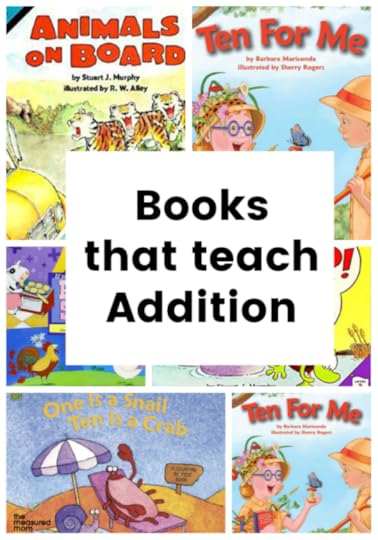
Looking for books that will help your learners understand the concept of addition?
Try these!
If You Were a Plus Sign, by Trish Speed Shaskan
This book explains what addition means, defines the plus sign, defines a sum, and more. It’s a great book for introducing an addition unit in kindergarten or first grade.
The Blunders: A Counting Catastrophe! by Christina Soontornvat
I read this book waaaay too many times at the request of my Four. In it, a woman has ten children. Exasperated by their behavior, she sends them out for the day. When it’s time to return home, the Blunder children believe one of them is missing. This is because each time one of them counts their siblings, s/he forgets to count him/herself. Help your learners see that 9 + 1 = 10.
Five Silly Fishermen, by Roberta Edwards
Five silly fishermen set off to catch fish. When they’re ready to come home, one fishermen counts to make sure they are still a group of five. The fishermen despair when they realize that one of them has drowned; after all, when the fisherman counts his friends, he counts only four. A clever little girl counts all five fisherman (and wins their fish in the process). A quick read, and another good one for teaching +1.
The 512 Ants on Sullivan Street, by Carol A. Losi
This fun story teaches the concept of doubling, which you can use as you teach the doubles addition facts. In this rhyming tale, a family brings a basket of goodies for a picnic. But ants (and more and more ants!) keep taking their food. First we have 1 ant, then 2, then 4, then 8, etc.
What I love most about this book is that it has extension activities in the back by renowned math educator, Marilyn Burns. Highly recommended!
One is a Snail, Ten is a Crab, by April Pulley Sayre and Jeff Sayre
This may be one of my favorite counting books of all time. It���s a ���counting by feet��� book. As in��� if you have 2 people, you have 4 feet. If you have 10 spiders, you have 80 feet. The book is just plain fun to read, but it also offers many opportunities for addition and skip counting.
Ten for Me, by Barbara Mariconda
Two friends go on a butterfly hunt as they race to see who will catch the most butterflies. I like how each page features a number sentence that equals 10 (4+6=10, 5+5 = 10, etc.). My Four and Six both requested this one often.
Animals on Board, by Stuart J. Murphy
This is one of my favorite books for introducing addition. My Four loved it and learned how to read addition number sentences using the pictures. On each page, another set of animals is riding on the back of a truck. We keep adding the animals together until the final pages, when we learn that they are being mounted on a carousel.
Ready, Set, Hop! by Stuart Murphy
Two frogs, Matty and Moe, have hopping contests throughout this book. Which frog can get to a location in fewer hops? The math isn’t as straightforward as I’d like in a book that introduces addition; use this one after children already understand the concept.
Quack and Count, by Keith Baker
Use this book to show your students how many different ways you can make the number 7. The text and pictures are great but very basic, so I wouldn’t use this past the beginning of first grade.
Math-terpieces, by Greg Tang
This is by far the most advanced book in this list. Use it with students who understand addition and are ready to make combinations of numbers to achieve a desired sum.
On each page we see images from a famous piece of artwork. Children are asked to find different combinations to make a particular number. Use this as a class and make a list of the number sentences on the board. Another option is to have students use this book in pairs at centers. Have them record their number sentences.
12 Ways to Get to Eleven, by Eve Merriam
This simple yet engaging book shows listeners 12 different ways to get to 11 … whether that’s nine pinecones and two acorns, or something more complex: four corners, two traffic lights, two chimneys, two cars, and one bicycle (all on Eleventh Street, of course). This would be a great book to read before a number talk.
Mission: Addition, by Loreen Leedy
This is a fun book, but it’s best read in pieces. Each “chapter” features a different concept about addition, such as:
Addition is combining sets.
When adding 2-digit numbers, add the ones and tens column.
When adding a large group of single-digit numbers, add the first two and add that sum to the next number.
How to solve addition word problems
The challenge with the book is that it’s very busy, with lots happening on each page. For clarity’s sake, it’s not my first choice. But you might have success with it if you show it to the whole class with a document camera.
The Mission of Addition, by Brian P. Cleary
This is a popular book for introducing addition, but it isn’t my favorite because the text is so difficult to read.�� Your listeners won’t care, though, and will enjoy the rhyming text and goofy illustrations.
Domino Addition, by Lynette Long
This is a brilliant book that is best used one-on-one or with small groups because you need to read it with a set of dominoes. I love the way it invites children to find dominoes whose dots have a particular sum. Children can discover a variety of ways to make a number, and the hands-on aspect makes it extra fun. Highly recommended, but not as a whole class read aloud.
What’s New at the Zoo? by Suzanne Slade
This is my all-time favorite book for introducing the concept of addition; it was a big hit with my preschooler. Each 2-page spread features an animal family at the zoo. When we add the adults and the babies, we have a simple addition problem which is recorded in the page. The book starts with a simple equation (2+1=3), and gradually builds up to 12+8 = 20.
Mall Mania, by Stuart J. Murphy
There’s a contest at the mall; the hundredth shopper to enter the mall will win all sorts of prizes. Four children stand at the entrances and use walkie talkies to keep track of the number of shoppers. This book is great for teaching students to add groups of numbers; I love that it shows two different approaches for each problem. The end of the book has even more math extension ideas.
© 2020, Anna G. All rights reserved.
The post Addition books appeared first on The Measured Mom.
September 13, 2020
When kids can’t remember what they read
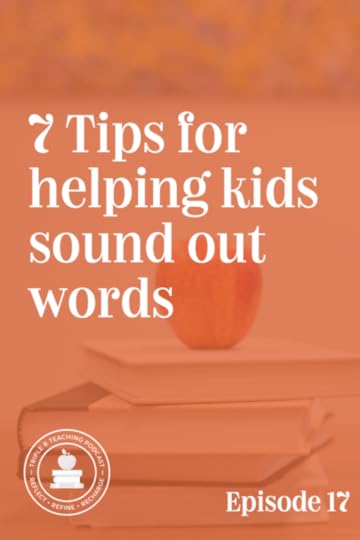
TRT Podcast#17: 7 Tips for helping kids sound out words
Is “sounding it out” just not clicking for some of your learners? These tips will help!
Learn the pre-reading skills kids need before they’re ready to sound out words.
Discover the power of oral blending.
Learn three different approaches to teaching kids to sound it out.
Get even more tips for helping kids find success with this important skill!
Full episode transcript
Transcript
Download
New Tab
You are listening to Episode 19, When Kids Can't Remember What They Read.
It is one of my least favorite experiences as a teacher or a parent. You've got a child who is halfway through a book and they look at you and can't tell you what they read. You ask questions, you try to get answers, but the child gives you a blank stare or a terribly confusing summary that makes no sense at all. That's frustrating. And it can be hard to know what to do, especially if it's a book that you, the teacher or parent have never read. So today I'm going to talk to you about some things you can try when learners don't understand what they read. If this sounds familiar at all, it's because you remember a blog post I wrote some time ago with these very same tips, but now I'm sharing them in a podcast episode.
So here we go, 10 things to try when learners don't remember what they read. Tip #1: Know what to listen for. The way you find this out is you ask them questions about the book and they can't answer them, or they tell you things that aren't exactly accurate, or they try to tell you about the book and it's just very confusing and clear that it really didn't stick. So when a child is telling you about a book, the first thing I recommend doing is familiarizing yourself with the book as much as possible. So scan the book yourself. It's amazing what you can pick up from the summary on the back or the inside flap, or the titles of the chapters. And then listen to how the learner is summarizing the book. If they're giving you every single detail, that's actually a problem.
And it's also a bad idea if they can't really tell you much of anything, right? What you're really going for is for them to tell you only the most important details, a summary. When they're summarizing for you, do they rely on you to feed them? So do they need you to say, "And then what? Okay. But why did that happen? Okay. But why did that happen? And then what?" If they need you to do that, it's like you're pulling teeth, then their comprehension isn't very good. If they feel comfortable and excited about the book and enjoy talking about it, chances are good they understand it.
Let's move on to tip number two. You want to make sure the book is appropriate for the reader. And that's why I think it's really important to make sure you know the child's reading level and have them choose within that range. So I am a fan of the Fountas and Pinnell guided reading levels. I have a blog post all about them. I will link to that in the show notes. I think that's very, very helpful because it gives you a range of books that are good for a child, especially when we're doing early chapter books.
I did something that I can hardly believe that I did because it took so much time, but I spent about six months reading and reviewing over 250 different chapter book series so you don't have to. And I did that because I know as my own children are reading, it can be very hard for me to know what chapter book series to suggest next based on their level. And I figured if I have that problem, other people do too. I know as a teacher, I certainly had that problem. So I created this long blog post giving you a quick summary of each series and their levels to show you what I think is a good choice for kids at different levels and interests. And then I also bundled them into a pack in my shop, which includes a huge variety of early chapter book book lists. So book lists for kids who like sports, for kids who like animals, things like that. And then also I have them organized by reading level. So this is a goldmine, and in my opinion, it's worth every penny, because not only will you get these book lists to help you match books to kids, but you will also get 75 reading response sheets that are perfect for helping kids keep track of what they're reading in a chapter book. These are open-ended, they can be used with nearly any book. And it's just a way for kids to keep track of their learning. But I'll get to that more later in this list of 10.
So after you know what to listen for, you've made sure the book is appropriate, it's about their level and their interest, you want to teach them to preview the text before reading. Think about when you get yourself a new book. I always preview the text, right? I look through it. I check what the chapters are called. I just see how long it is. I always read the back or the front cover. Teach your students how to do that. That's just priming the pump and getting them ready to read the book. You don't want them to read a book cold. And that would mean just starting on the first page without any understanding at all of what the book is about.
Tip number four is to teach them to monitor their comprehension. I know when I was having this problem with one of my boys that he wasn't remembering when he was reading, I would come up and talk to him about it. And we could be halfway through the book and I would say, "Tell me what happened here." And he would be, "I don't remember that. That was four chapters ago." Or he would be reading to me and we would stop and I would say, "Tell me about what you just read," And he wouldn't know. Personally, I have had that experience where I read a whole bunch of something and it goes in one ear and out the other. That can happen with our students and we have to teach them to notice when that's happening, to monitor their comprehension. If they get to a stopping point and they don't remember what they just read, they need to learn how to go back and then reread. That's very important.
So that moves us into tip number five, which is to teach fix up strategies. They need to know what to do when they're suddenly not understanding. So one thing is to reread. Another problem could be understanding some tough vocabulary. So getting help from an adult or a dictionary to learn what some words mean. To slow down and read that confusing part slowly. Maybe there's some text features if it's a nonfiction book that can help them understand the text better, or teach them how to create a visual in their mind, or even sketch it on paper as they read. I remember when I was in college in biology, I would take a piece of paper and draw all the new concepts I was learning because science does not come naturally to me and really wanted an A in that class. So the only way for me to retain all the stuff I was learning was to create a visual of it for myself. Your students can do that too.
Tip number six is to make sure your learner has a purpose for reading. Now that may just be to enjoy the book, but if they're reading for school, the purpose is to understand it, right? And so we want them to sometimes set shorter goals than read and understand the whole book. So it can help if they have a sticky note maybe at the end of one chapter. And then you tell them, "When you find the sticky note, I want you to find me and tell me the most important thing that happened." And of course, if you're busy, they may want to write that on the sticky note or a piece of paper and they can come see you later. But if you're at home with your child, it's easy for them to come find you. Maybe you're cooking dinner and when they get to a certain page, they need to come give you a summary.
Other things they could do would be if it's a nonfiction book, tell them to read these two pages and then tell me the most important thing the author wants you to remember. Or read these pages or this chapter and tell me the problem the character is having. Or again, with a nonfiction book, read this section and then tell me a question you still have about this topic. So there are many different things that you can do to give kids a purpose for reading, even just a small chunk of text.
Tip number seven is to use a paperclip. This is a lot like the sticky note tip, but it is to put a paper clip where you want them to stop and engage with the text. And this could be talking to themself, maybe tell themselves what they remember reading. If you have some kind of recording device where they could actually record themselves talking about what they've read so far, if you're home, the child can just come to you and tell you what they've read when they get to the paperclip.
Number eight is to use sticky notes more. So I talked about using sticky notes as a stopping point, but they can also be a recording space. Sticky notes are seriously unappreciated and it's amazing how many possibilities they hold for our young readers. So imagine the things they could write on them. For example, I think blank will happen next. Or at the end of a chapter, they could write, blank just happened. The most important thing in this chapter was, or a question I still have is, so this is just a visual stopping space with a prompt on it so they know what they need to think or write about.
Tip number nine is to work through a graphic organizer. Now I mentioned earlier that my mega pack of booklets for early chapter book series comes with 75 graphic organizers perfect for early chapter books. And so if you go through that, you will find lots of ideas for helping kids talk through a story. At first, you may not have them write in the organizer and that's okay because having that visual of things to talk about can also be extremely helpful. Organizers are great, but I want to encourage you not to overdo it. So don't assign too many in one week or you'll burn your children out. Show them how to use that organizer to help them keep track of what they're learning. It may not be for a grade. It may just be a tool to help them understand what they're reading.
And my last tip is to think conversation, not quiz. This is really hard to do and I fail at it most of the time. But it's so important to remember that when you're talking to a child about a book, try to make it a conversation and not a test. So imagine you're talking to another adult about a book you've both enjoyed or that she or he has read and enjoyed and you want to know more about it. Try to make it be more like that rather than, then what happened? Then what happened? Why did he do that? Then what happened? What happened in this chapter? That can feel kind of like hammering and we want kids to enjoy their books and to enjoy conversations with us about them. So imagine you're in a mini book club so that your students know that they get to talk about it with you afterward, not be tested.
So those are my top tips for helping kids who struggle to remember what they read. Let's recap. Number one, know what to listen for. So scan that book so you have some ideas about what it's about and notice how the child is telling the story. If they're comfortable, if they're halting. Number two, make sure the book is appropriate by checking the reading level. Again, I encourage you to check out my early chapter book list. I'll link to that in the show notes. Number three, teach them to preview the text before reading. So take a look at the back. Look at the chapter titles before they read. Number four, teach them to monitor their comprehension. So they should be able to know when they're not understanding what they're reading. So that number five, they can apply fix up strategies like rereading or reading a part slower.
Tip number six is to give them a purpose for reading. And often these are smaller for smaller chunks of time. So you might say read just this chapter so that you can tell me this. Tip number seven is to use a paperclip so they can mark the place where you want them to stop. Or tip number eight, use sticky notes. And those are often a great place to actually record their thinking. Number nine, talk them through a graphic organizer. I've got 75 of those waiting for you. And number 10, think conversation, not quiz. So in the show notes, I will link to the early chapter book blog post that I have as well as the bundle in my shop and some other things that I've mentioned in this podcast episode. And you can check out the show notes at themeasuredmom.com/episode 19. Thanks for listening, and I'll talk to you again soon.
Scroll back to top
Sign up to receive email updates
Enter your name and email address below and I'll send you periodic updates about the podcast.
powered by
Resources and links mentioned in this episode
B
Subscribe & review in iTunes
Are you subscribed to my podcast? If you���re not, I want to encourage you to do that today. I don���t want you to miss an episode!�� Click here to subscribe in iTunes!
Now if you have an extra minute, I would be really grateful if you left me a review over on iTunes , too. Those reviews help other people find my podcast, and they���re also fun for me to go in and read. Just click here to review. You’ll need to click to “Listen on Apple Podcasts” and “write a review.”�� Let me know what you appreciate about the podcast. Thank you!
There are many ways to listen …
Subscribe in iTunes
Subscribe in Spotify��
Subscribe in Stitcher
Looking for the entire podcast library?
Click here to see all episodes
Episode 19:
Related posts”
Fountas & Pinnell guided reading levels
Ultimate guide to early chapter book series
Fix up strategies
© 2020, Anna G. All rights reserved.
The post When kids can’t remember what they read appeared first on The Measured Mom.
Books about Fall
Check out my giant list of fall books for preschool and up!
This post contains affiliate links.
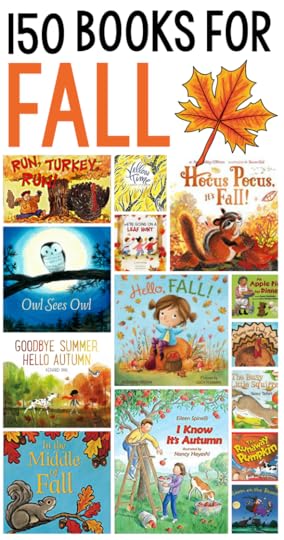
Over the years, I’ve shared quite a few book lists about fall – because I absolutely love this season! I’ll start this post with a list of general books about fall. Down below, you can click on any of the images for even more books about fall … apples, pumpkins, leaves, scarecrows, Halloween, and Thanksgiving!
Short on time? Click here for a printable list you can take to the library.
Here we go!
Fall Is Not Easy, by Marty Kelley
This is a delightful rhyming book about a tree who struggles to change its colors for fall. Instead of turning into traditional fall colors, its leaves are colored like a rainbow, a giant smiling emoticon, polka dots, a hamburger (our favorite!) and more. Lots of silly fun while also teaching kids about the seasons.
Fall Mixed Up, by Bob Raczka
My Four and I giggled as we read this funny book about things that aren’t quite right during the Fall season. We get a hint that things are mixed up on the very first page: “Every Septober, every Octember, Fall fills my senses with scenes to remember.” The rhymes are cute, but it’s the illustrations that steal the show. Our favorites were the pictures of squirrels flying south for the winter (suspended by red balloons), and kids taking big bites out of caramel pumpkins.
Bella’s Fall Coat, by Lynn Plourde
Bella loves her Fall coat – that Grams made especially for her – to last forever. But the coat is worn out, and Bella is too big for it. Thankfully, Grams has a solution. This sweet, vibrantly colored book was a favorite of my Four.
This is a gorgeous book with hinged pages. My Two and Four loved taking turns opening them after the magic words. I love the simple, cheerful text – and the fact that it rhymes, which is always a plus when choosing books for toddlers and preschoolers.
The Busy Little Squirrel, by Nancy Tafuri
This is a simple book about a squirrel getting ready for winter. He’s too busy to nibble a pumpkin with Mouse, rest on a branch with Bird, or hop rocks with Frog. He’s too busy! The short story and sweet illustrations make this perfect for toddlers.
Goodbye Summer, Hello Autumn, by Kenard Pak
I love the way the young girl has conversations with the flowers, creatures, and weather as the season changes into winter.
“Hello, trees.”
“Hello! Now that the cool winds have come, we love how our branches sway in the sun.”
This would be a great mentor text for teaching kids to write their own books in the same style. I will be honest, though, and tell you that my Four disliked it. She thought it was boring.
Yellow Time, by Lauren Stringer
My Two is learning to name all his colors, and the first one he latched onto was yellow – making this a perfect book for us! While my Four felt the story was boring, I liked the delightful artwork and gentle text.
I Know It’s Autumn, by Eileen Spinelli
This is a cheerful book that may be worth owning, especially if you are a classroom teacher of preschool through first grade. It has engaging pictures and just the right amount of text.
On each page, the narrator notices something different that tells her autumn is here. “When the morning light comes late … when Daddy brings my jacket from the storage box … when the class makes acorn art …” and so it goes. A bonus is that the book features a multi-racial family (a Caucasian mother and an Asian father).
In the Middle of Fall,��by Kevin Henkes
I love the simple text and gorgeous, soft illustrations in this gentle introduction to Fall. Perfect for kids with short attention spans.
Hello, Fall! by Deborah Diesen
This is a sweet book about a little girl and her grandpa. Together, they find beauty and wonder in the fall foliage.
Owl Sees Owl, by Laura Godwin & Rob Dunlavey
You’ll fall in love with the sweet baby owl in this poetic book about a young owl’s nighttime adventure. What’s very cool is that book is written as a reverso poem. A reverso poem is one in which the second half repeats the lines from the first half. You’ll have to check this book out to see what I mean. 

Click on an image below to get another book list for fall!
© 2020, Anna G. All rights reserved.
The post Books about Fall appeared first on The Measured Mom.
September 10, 2020
Fall visual discrimination activity
Grab this free visual discrimination activity for Fall!
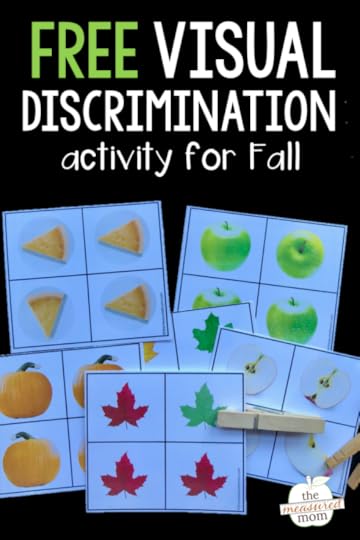
Visual discrimination activities are important. When kids have to look at a set of pictures and identify which one is different, they’re practicing the skills they need to distinguish between letters and numbers. This is especially important when comparing tricky letters such as��b and��d.
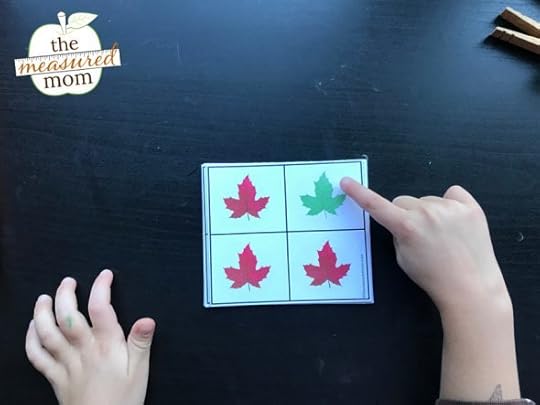
I simply printed the cards and asked my daughter to identify which image was different. Some were simple – like this one.
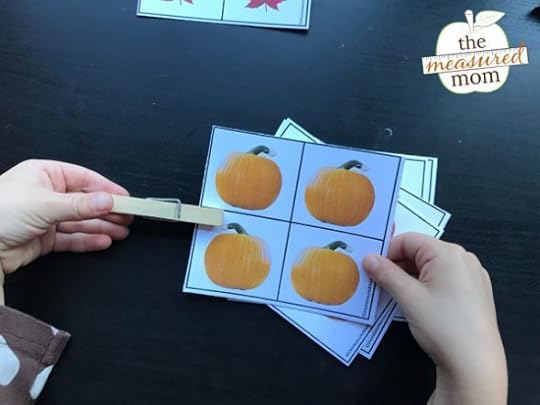
Others were a bit trickier – like this one with the pumpkin stem facing the opposite direction.
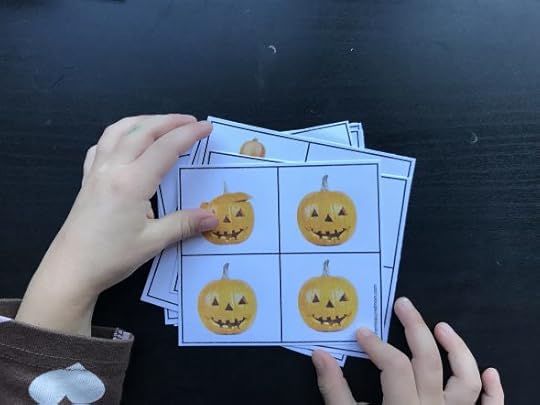
She enjoyed this activity and had no problems with it.
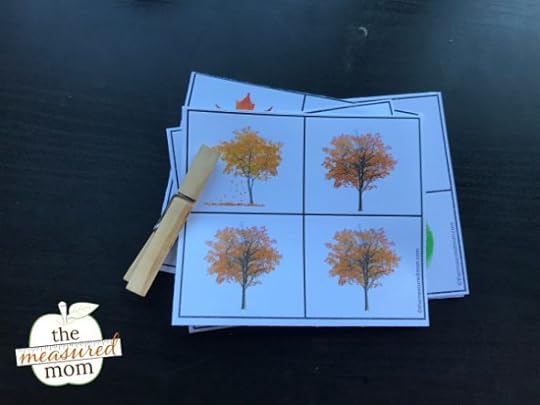
My Four asked if we should have my Two do this activity. He’s not quite ready yet. 
I hope you can use these cards at home or in your classroom!
Looking for more free visual discrimination activities?
Grab a variety of printable cards at Prekinders��and Pre-K Pages.
More free resources!
© 2020, Anna G. All rights reserved.
The post Fall visual discrimination activity appeared first on The Measured Mom.
September 9, 2020
Editable fall spelling game
Check out this fun editable spelling game – perfect for fall!
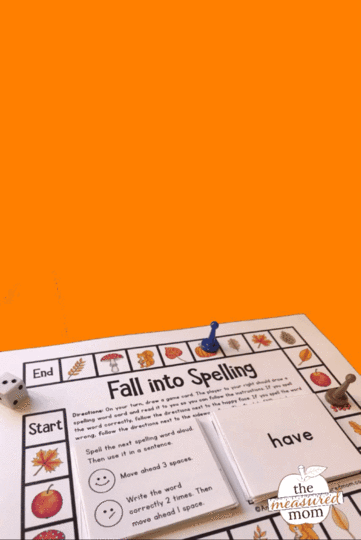
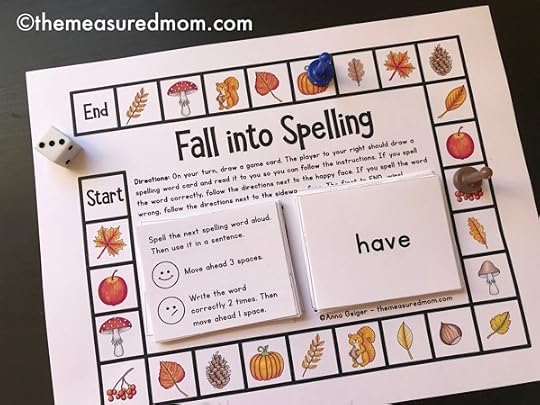
I know how hard it is to spice up spelling practice … so I created this simple fall spelling game. The game cards are the same, but you can type your own words into the spelling word cards! The game is cute, but not��too cute, so you can use it for kids in (late) first grade through fifth grade!
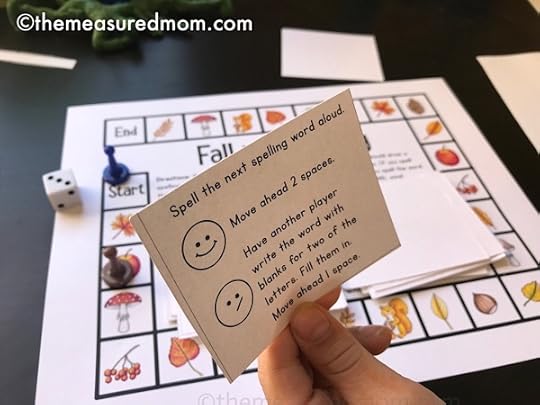
To play, a student draws one of the 18 game cards and reads the directions at the top. Here are the various directions you’ll find on the cards (all are repeated):
Spell the next spelling word aloud.
Spell the next spelling word aloud. Then use it in a sentence.
Write the next spelling word on paper.
Spell the next spelling word aloud. Then use it in a sentence. Draw a picture of your sentence.
Look at the next spelling word. Read the word aloud. Then say all the letters. Now flip it over and write it.
Spell the next spelling word in your best robot voice.
Another player should write the word 3 ways. Only one way should be correct. Choose the correct spelling.
Rip a piece of paper into scraps (or grab small sticky notes). Write the word, one letter per piece.
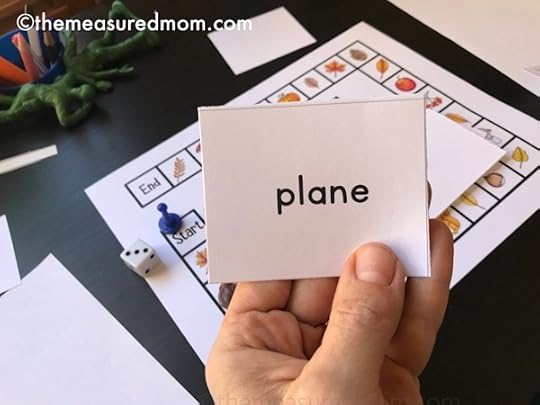
The player to his/her right reads the next word card.�� Then the player follows the directions (as described above).

If the player is correct, h/she follows the directions next to the smiley face. If incorrect, h/she follows the directions next to the sideways face. If they spell correctly, they move forward. If they spell incorrectly, they practice the word a few times (as directed on the card) before moving forward a fewer number of spaces.
Which of course means that the die is not necessary. I’m not sure why I included it in the picture. Sorry about that.
I played this game with my first grader. I typed in words with short a, words with long a spelled CVCe, and a few oddballs, such as��have��and��what.��
We had fun with this game, and I hope your learners do too!
Get more freebies!
© 2020, Anna G. All rights reserved.
The post Editable fall spelling game appeared first on The Measured Mom.
September 8, 2020
15 fall sight word games (for all the Dolch lists!)
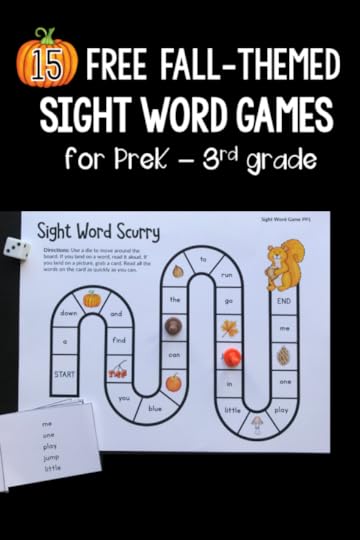
My blog subscribers have been asking for sight word games – so I created a set of games that feature��all the Dolch sight words … from the preprimer list all the way to the third grade list.
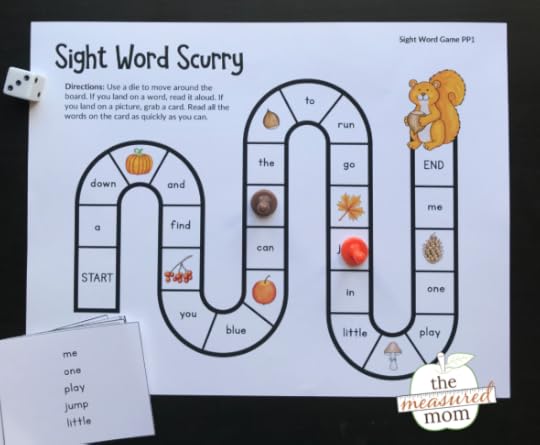
There are 5 main lists for the Dolch sight words: preprimer, primer, first, second, and third grade.
Since each game can only feature 20 words, I created three games for each level.
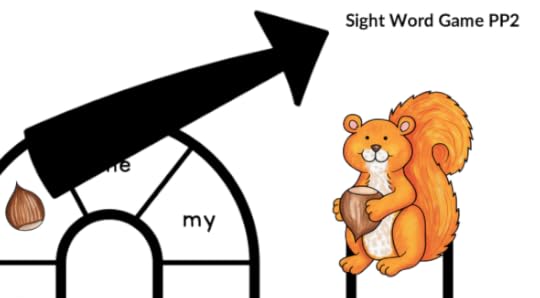
You can find the level for each game in the upper right hand corner. In the above example, the game is for the preprimer sight word list.
PP1, PP2, PP3 – preprimer games
P1, P2, P3 – primer games
1G1, 1G2, 1G3 – first grade games
2G1, 2G2, 2G3 – second grade games
3G1, 3G2, 3G3 – third grade games
I chose to use a kind of “code” to write the levels because I realize you may use these games with older, struggling readers. I don’t want them to be discouraged that they are playing a�� first grade level game.
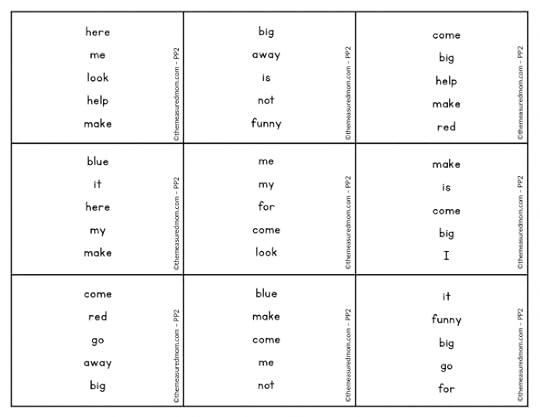
Each game also comes with a set of word cards.
How to play:
Choose a game board. Then print the board and accompanying cards. Cut the cards apart.
Grab playing pieces and a die.
Take turns moving around the board by rolling the die. If a player lands on a word, s/he reads it aloud. If a player lands on a fall picture, s/he takes a card and reads the list as quickly and clearly as possible.
The first player to reach the squirrel, wins!
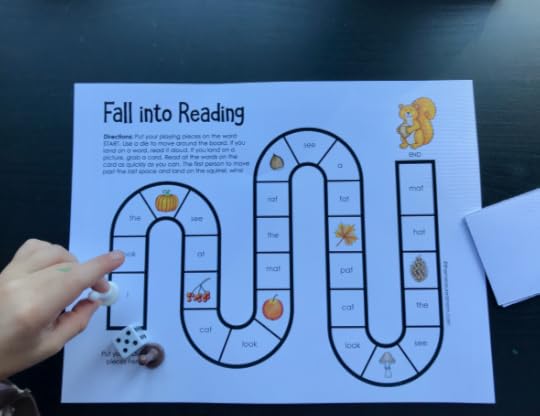
I played this game with my preschooler. She is not ready for the preprimer sight word list yet, but she does know a few sight words and can sound out words that end with -at. (This is all thanks to the lessons we’ve been doing from my favorite preschool reading curriculum, Reading the Alphabet).
Since she’s not ready for the games in the packet, I used the the free editable version and typed in my own words (email subscribers can find this for free in the subscriber library!).
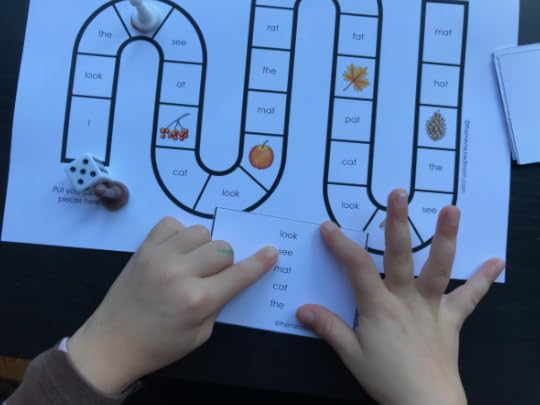
I was so pleased (and, admittedly, a bit surprised) at how well she did! She enjoyed the game so much that we played it three times.
And even though she was playing against a much stronger reader, she won two times – thanks to the roll of the dice.
I do hope you can use these fun fall sight word games!
Get our giant bundle of EDITABLE sight word games!
© 2020, Anna G. All rights reserved.
The post 15 fall sight word games (for all the Dolch lists!) appeared first on The Measured Mom.
September 7, 2020
Fall vocabulary activity
These free pocket chart sentences will help your preschooler learn some basic Fall vocabulary. ��We hope you have fun with them!
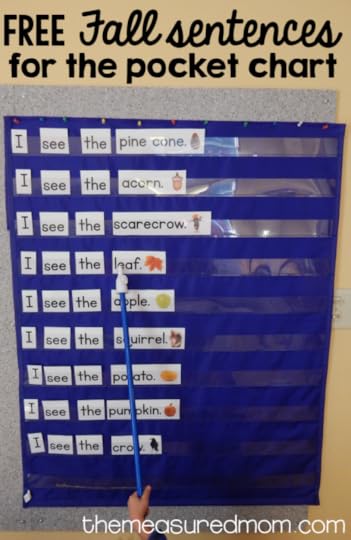
(This post contains affiliate links.)
If you haven’t purchased our Fall Theme Pack yet, you haven’t seen these fun pocket chart sentences that come in the giant bundle of preschool and kindergarten activities.
We love pocket chart sentences for quite a few reasons!
They teach basic concepts and vocabulary.
They help my preschooler learn concepts of print.
They bring attention to common sight words.
They’re FUN!
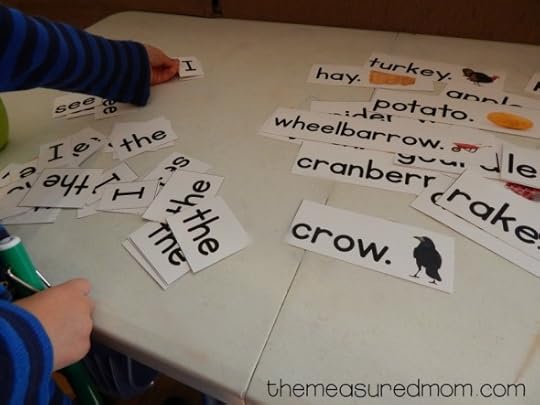
First, I printed and cut apart the sentences.
My Three loved sorting the word I, see, and the. ��He could read I, of course, and with some help remembered the word see.
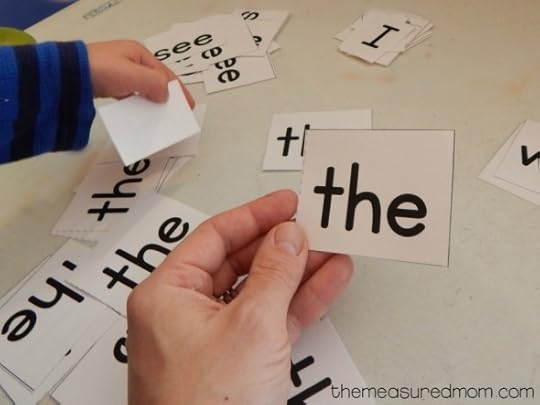
The word the, however, was a tricky one- especially without a beginning sound clue. ��He constantly needed me to tell him what the word was.
But that’s perfectly fine. ��Since he’s really not ready for sight words yet, my purpose for this activity was to build concepts of print: specifically, the understanding that each printed word represents one spoken word.
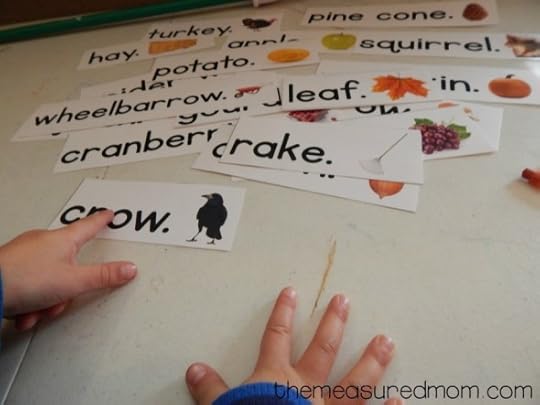
He chose a Fall word to complete his first sentence.
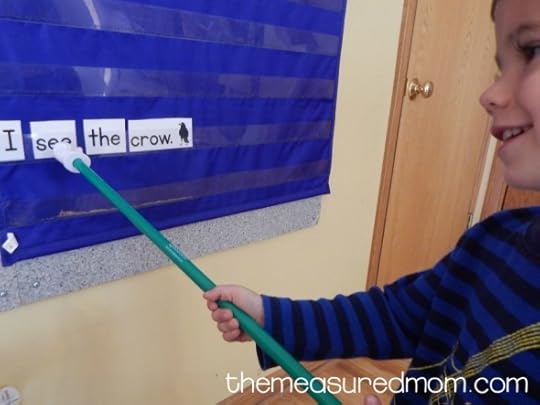
Next, he put the words on the pocket chart in��the order that I gave��him. “We’re going to make the sentence I see the crow. ��Let’s put up the “I” first. ��Now can you find “see”? ��Here’s the word “the.” Now it’s time for��your Fall��word and picture.”
When my Three��put the words up, he wanted to cram them all��together, but I pulled��them apart so he could see each individual word.
Look at that smile! He loves reading with our new pointer.
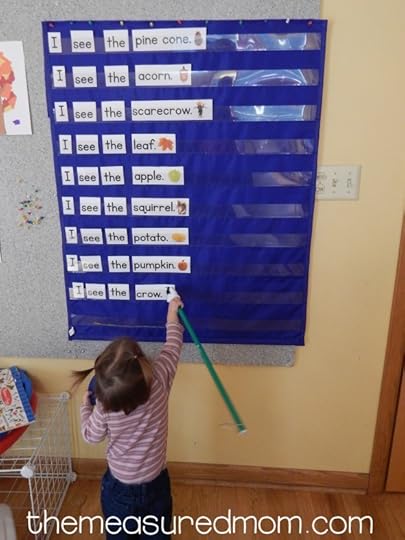
After he made and read three sentences with me, he was tired. So I built the rest of the sentences while he watched. (And a certain little one-year-old had to have a turn! ��I just love hearing her nonsense words as she pretends to read.)
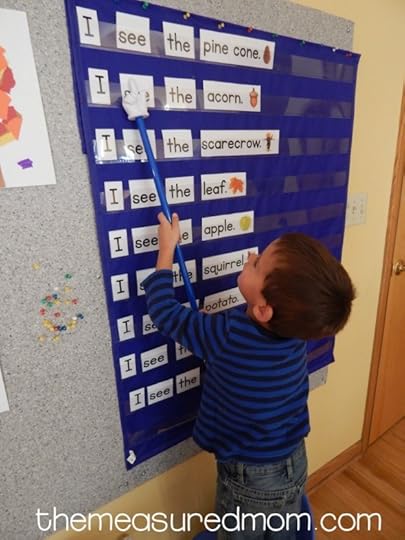
Finally, my Three read all the sentences himself using the pointer and picture clues.
I just love how pocket chart sentences reinforce concepts of print, teach sight words, and build vocabulary all at the same time! (Plus, they’re a great confidence booster!)
Want to build more Fall vocabulary? Check out our book lists!
Books about apples
Books about leaves
Books about pumpkins
Did you know?
In my Fall Theme Pack you’ll get 250 pages of Fall-themed activities, including a variety of pocket chart sentences:
types of Fall leaves
the life cycle of an apple
the life cycle of a pumpkin
Fall vocabulary (download for free below!)
Have fun!

© 2020, Anna G. All rights reserved.
The post Fall vocabulary activity appeared first on The Measured Mom.
September 6, 2020
When sight words won’t stick
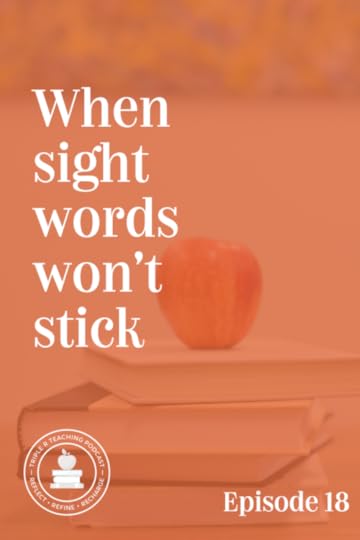
TRT Podcast#18: When sight words won’t stick
What can you do when learners can’t remember those tricky sight words … no matter what you try?
Today I’m sharing five tips that will help!
You will learn
how to teach new words explicitly
how to practice the words both in context and in isolation
how to make sight word learning multisensory
Listen to the full episode here
Full episode transcript
Transcript
Download
New Tab
You are listening to episode 18, When Sight Words Won't Stick. I just want to say welcome back. Thank you so much for tuning in. If you're listening to this in real time, we're in the early fall or late summer of 2020, and you may have noticed that it's been a while since I posted an episode. That's because we've had a lot going on here at our house, what with the pandemic and having my kids home all the time. There hasn't been a lot of extra time to do things. But I also have a really, really big project that I'm doing, which is taking up the time that I have. And that is I'm working with a designer and a developer to completely redesign themeasuredmom.com website. So that's going to be really exciting. I'm hoping that that's ready to go the end of September, but that's the reason why I haven't posted a new episode in over three months.
I am really excited to be back with you. And we are picking up in the middle of our eight-part series about helping struggling readers.
So, so far we've talked about helping learners who struggle to learn the alphabet, quick tips for teaching letter sounds, how to build phonemic awareness and seven tips for helping kids sound out words. Today, we're going to talk about what to do when kids have trouble learning sight words. Sight words, of course are words that cannot be sounded out phonetically, at least not all the way through. And so kids need to learn them by sight. Hence, the name.
The first tip I have is to remember that many parts of sight words can be sounded out. So we don't want to jump right to flashcards. We want to take a look at each word and examine the parts explicitly. So for example, if you had the word from, you could teach your learners that the F, the R and the M can be sounded out using phonics knowledge. It's that tricky O in the middle that makes it a sight word. So you would examine each letter, talk about the sound that it makes. And then take note that the uh sound in the middle is actually represented by an O instead of a U. There's a website, it's called a reallygreatreading.com and they have these wonderful animations that show you how to explicitly teach these sight words that are mostly phonetic, but have a couple tricky letters in there. I'm going to give you a link to those in the show notes, and it's definitely worth checking out. You can show your students any of those free animations, and you can also use them as inspiration for making your own.
Tip number two is to give kids practice writing the sight word. A lot of times we focus so much on reading it, we forget to have kids practice writing it. When they do that, you can work through the letters explicitly with them as you did when you taught the word, and you can maybe have them grab a highlighter and highlight any letters that make an unexpected sound. You can also have your learners write the words on some kind of special surface like shaving cream, or they can use a chopstick and write the words in colored sand. There are lots of different ways to help your kids who need to learn things in multisensory ways.
So far, we've talked about practicing the words in isolation, both by teaching those individual letters and by writing the word. But it's also really important to follow tip number three. And that is to have kids read the words in context. And this is where simple sight word books are very useful. I have a lot of these on my website, I believe over 40, that are free for you to download. So I'm going to leave a link to that in the show notes as well.
Tip number four is to figure out a way to repeat the words in a fun way. So certainly you can use flashcards. They do have their place, but you're going to want to do something besides flashcards. And we have an active Facebook group, actually, we have three of them and one of them is called Kindergarten and First Grade Teaching Ideas. Last I checked, we are almost at 10,000 members and it's a very active group. Recently, someone asked a question about helping their child with sight words, because they struggled to remember them. And there were so many good ideas there.
So I'm going to pull from some of those ideas for this tip. You can put two to three sight words by the door. So maybe by the light switch, and this could be in your classroom or a resource room or at home. And every time that particular child leaves, they're supposed to tap the words and read them out loud. Of course, now in the time of COVID, you won't want them to touch the words, but they can point to them and say the words as they leave the room.
Something else you can do. This was probably something more for home or maybe in a resource room, but you can give students a lanyard. So one of those name tags that you wear around your neck with the little clip and inside it, instead of putting a name tag, you can put the sight word, and then the child would actually lift up the lanyard to read the sight word and get extra practice that way. Of course, you'd have to have the sight word inserted upside down so that when someone looks at the child, it looks upside down. But when they pick it up to read it, it's right side up. So I would suggest putting a special sight word in their lanyard and periodically having them flip it up and read it to you.
Something else you can do is play hide and seek where you have multiple copies of just three words, and you hide them around the house and your child finds them and reads them. There are many other ways to make sight word learning playful, and I'm going to link to some of the ideas that I have on my website in the show notes.
My fifth tip is to help your child use their body while they're learning sight words. A great way to do this is to do a sight word song that has actions. I would definitely check out Heidi Songs if you have not, again, I'll leave a link to her in the show notes. Heidi is a kindergarten teacher who has created some wonderfully catchy sight word songs with full body actions. So those are really great for helping kids internalize the spelling of a lot of sight words. And then if you do that with the screen, because she has it on a DVD, they can actually see the words as they're singing that.
Some people teach students to tap the word on their arms. So for example, if the word is the, they might touch their shoulder as they say T, touch their upper arm as they say H, touch their lower arm as they say E and then slide their arm all the way down from the shoulder to the wrist saying the word. So I've got my right arm extended, my left arm is tapping THE. The.
Another member had this idea. She calls it dribble and shoot where she said that she teaches her students to pretend to dribble the letters and then shoot the basketball when they say the word. So for the, it would be T-H-E, the. So imagine them hitting the air, sort of like they're dribbling a basketball for those letters, and then moving their arms way over their head for the word, the.
Other things you can do would be to teach your students stomping and clapping movements for particular songs, some kind of rhythm that they can do maybe as they march around the room. So think about involving the whole body, if necessary.
My last tip for helping learners, who struggle to learn sight words is to use magnetic letters or letter tiles. So there is a blog post I have about using magnetic letters to teach sight words. It's based on the method that Jan Richardson recommends in her book, The Next Step Forward in Guided Reading. I'm going to link to that in the show notes, but here's an idea from that set of steps. You would have kids build the word with magnetic letters, and it's nice to use the letters that are actually the shape of the letters and not just a letter tile, because they can feel the shape of the letters as they're spelling the word. You have them, make the word, then mix it up and then build it again.
Something else you can do is take a letter away, have them build the word, leaving a space for the missing letter, and then write that letter in the missing space. So maybe you're doing this on a board, like a dry erase board or a piece of paper. Do this several times, maybe take away two letters next time, and then three, until they can simply write and read the whole word.
So those are some ideas for helping kids when sight words just won't stick. Let's review.
Number one, you want to examine the word and talk explicitly about each part, remembering that oftentimes most of the word can be sounded out. There may just be one or two troublesome letters.
Number two, give your students practice writing the sight word, whether that's on a regular piece of paper, in shaving cream, on a dry erase board or something like that. And then you could have them highlight the tricky letters.
Tip number three, have kids read the words in context often in the form of little books.
Number four is to playfully repeat those words. So lots of practice, repeating the same words over and over. This may include flashcards, but I recommend games as much as possible.
Tip number five is to help kids use their whole body as they learn the sight word. And so this may involve tapping, dribbling, stomping, dancing.
And finally, tip number six, have your learners use magnetic letters as they practice reading, building, spelling, those sight words.
I have a whole set of editable sight word games on my website that I highly recommend if you're helping learners master sight words. There are 150 different games included in the bundle. You can type in any words you want and they will auto-populate into the games. The fun thing about this pack is it's seasonal so there's something for any time of the year. So to check out my editable seasonal sight word games, you can go to themeasuredmom.com/sightwordgames, and you will find this bundle from my shop. I'll also leave links to everything else I mentioned in the show notes, which you can find at themeasuredmom.com/episode18. Thanks so much for joining me and I'll talk to you again next week.
Scroll back to top
Sign up to receive email updates
Enter your name and email address below and I'll send you periodic updates about the podcast.
powered by
Resources and links mentioned in this episode
Sight word animations from reallygreatreading.com
Free sight word books
25 low-prep sight word activities
Heidisongs’ sing-along songs that teach
How to teach sight words blog post
© 2020, Anna G. All rights reserved.
The post When sight words won’t stick appeared first on The Measured Mom.
Anna Geiger's Blog
- Anna Geiger's profile
- 1 follower


